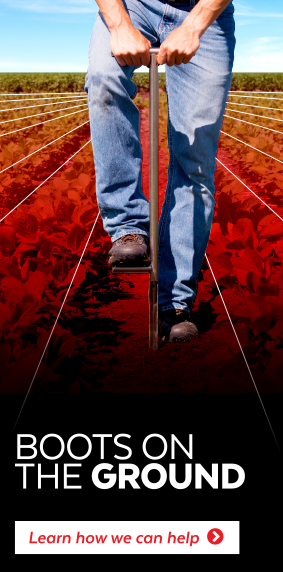Crop scouting is basically an art form. Knowing what to look for out in the field is the key to success. By doing it right, scouts can help a grower proactively react to changes in the field and crop conditions. E4 Crop Intelligence is going to highlight a few things that crop scouts look for in your field.
Germination & Emergence
After seeding, scouts will return to the field when the crops germinate and emerge from the ground. They’ll look to see how uniform the plant stands are, identify if the planter had any skips that created gaps in the rows, uneven plant spacing, and evaluate the overall health of the seedlings.
Uniformity in emerged crops is a sign that the seeds had access to moisture in the seed zone and were planted at the right depth. A uniform crop stand has a significant impact on overall crop yields.
Any skips in the rows could indicate a problem with the planter, such as improper seed meter set up, low or high vacuum pressure, not enough tension in drive chains, or the seed bouncing out of the furrow. On the flip side, uneven plant spacing could be caused by worn-out seed tube guard, excessive row-unit bounce from the field, faster planting speeds, or seeds dropping directly out of the seed meter.
Scouts will check to see if the seedlings are in good health and if they have been affected by exposure to the weather, diseases, or insects. These early evaluations will help determine if replanting or if disease and insect treatment are required.
Weed Pressure
Crop scouts look for weed pressure throughout the growing season. They look for any known weeds and identify any new invading weeds that might appear. With this type of information, scouts can make recommendations of the best herbicide control methods. Notes are also made on the location of any encroaching weeds. Overall, the continued scouting for weeds throughout the growing season helps inform on future management options and plans.
Disease Pressure
When looking for disease pressure, crop scouts inspect plants for damage from diseases. They do this by observing the roots, stems, leaves, and seed pods or heads. Different diseases affect specific areas of the crops. Tissue samples may be taken for a lab examination to confirm the diagnosis. The inspection for disease pressure will assist in determining if fungicide application is necessary.
Insect Pressure
When scouts are in the field looking for weeds and diseases the crops are also evaluated for damage from insects and other pests. Scouts also look at the roots, stems, leaves, and seeds for signs of insects. If insects are present, crop scouts have to gauge whether the number of bugs meets a threshold that requires control. The reason for having a certain threshold ensures that any insecticide or control option is going to be economical and impactful.
Crop Scouting With E4
E4’s expert crop scouts not only inspect fields rigorously for these different crop pressures, but they also provide a level of detailed crop inspection that is not commonly found with other services. Customers who have the E4 Scouting and Field Note services benefit from requesting inspections and indicating the number of scouting trips they would like E4 to make throughout the growing season.
Field technicians will record observations regarding the general field needs and conditions, disease and weed pressure, and any mechanical issues found on a digital field map using the E4 Field Notes software. The information is then available to the grower as a Scouting Report. Growers can make informed decisions, take action, and spend resources wisely through this crop scouting service. For other expert insight about what you can expect from E4 out in the field, explore other helpful articles on E4CropIntelligence.com.

